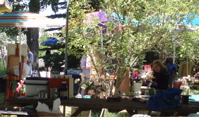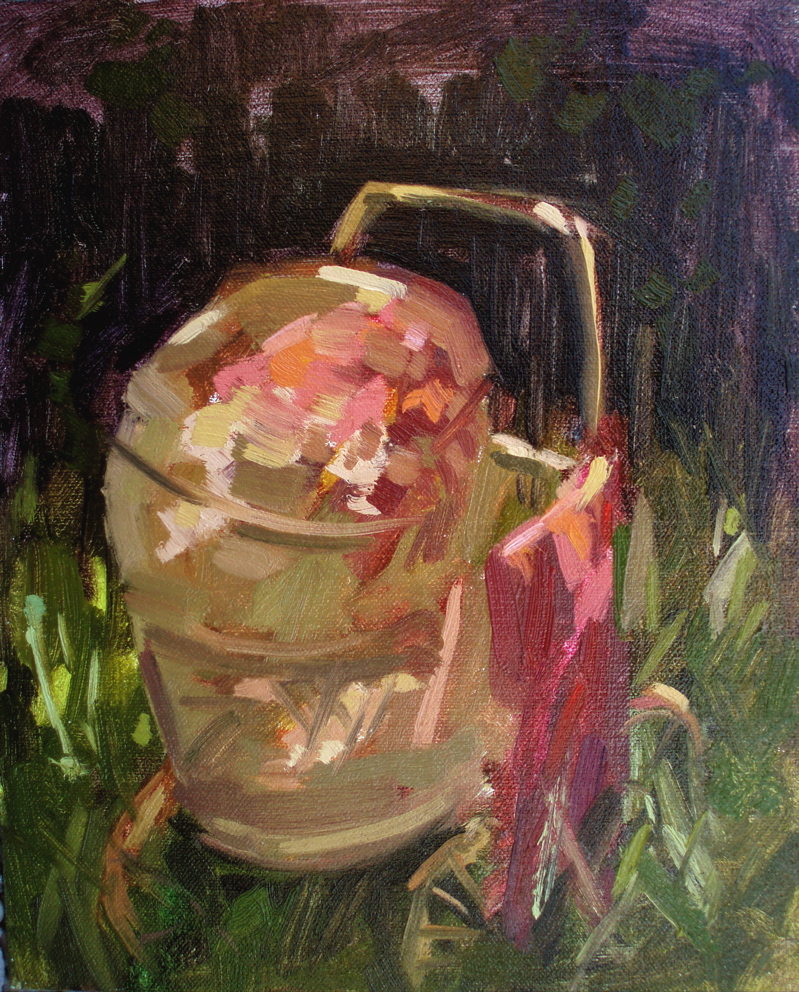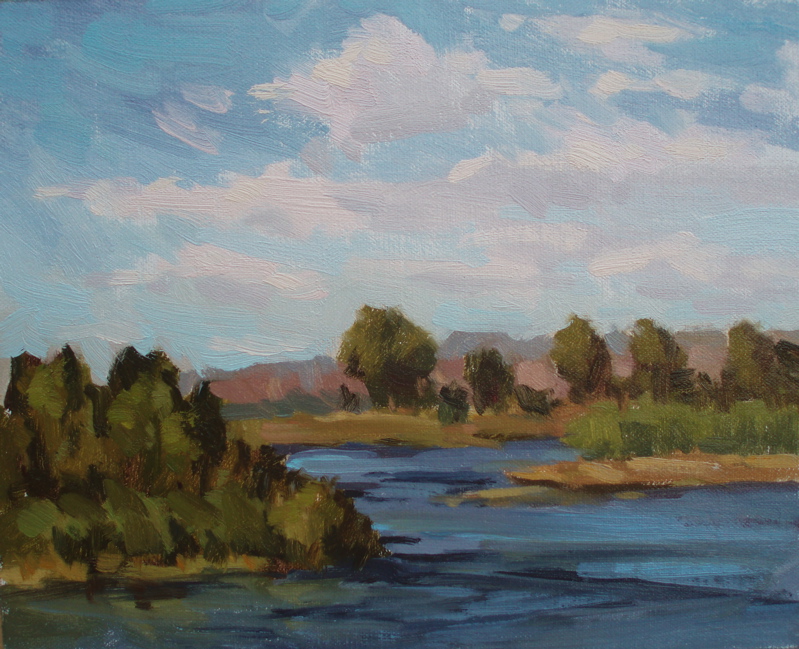
Great day! I’m glad I attended again this year, as already in the first day I heard some much needed clarification on his technique. Here are today’s key take-aways:
- Brush Cleaning. A brush cleaning tip: wash your brush in solvent, then work in Walnut Oil and leave in over night. Supposed to keep the brush well nourished. I’m trying this today. I’d love to stop cleaning my brushes every night with soap and water (after solvent, of course).
- Limited Palette. He emphasized a basic palette for beginners, although with a surprising triad of colors: Thalo Blue; Quinacrodone Red; and Cad Yellow Light. The first two are pretty powerful colors, so this surprised me. He emphasized the need for cool versions of colors in a basic landscape palette, since outdoors you get a lot of reflected blues from the sky.
- Using Grays. He mixes a basic gray of Black and White, to tone down most colors. If you have a pile of warm and cool muds, these can also be used to tone down the intensite of warm and cool colors, respectively.
- Mix Adjacent Colors. No matter your palette, to avoid muds, mix only colors adjacent on the color wheel.
- Start Flat. Emphasized starting with flat shapes. No painting of petals allowed! Just focus on accurate values and color temperatures. 90% of your painting time should be on values and shapes, leave the detail to the last 10% of time.
- Toning Canvas. This was a point of confusion last year, and I think he cleared it up, some. He alternatively follows two different techniques:
- Value 3 Gray. This is a fairly light gray tone, that he mixes with Thalo Blue and Black. He said he tones with a combination of Damar Varnish and Gum Turpentine Spirits. Very light wash, runny. Leave to dry 30 minutes before painting (at least in the dry, hot Idaho sun). He recommends this for beginners, as toning the canvas in this way will help you see values better (eg, lights will show up well, as opposed to a full white canvas.). He also uses this gray himself on landscape works (less so still life paintings), so I don’t think this is just for beginners.
- Full Color Wash. I’ve written about this before, after my first workshop. You use unmixed, out-of-the-tube colors to lay down your first layer. Go bright, as you’ll leave these bright areas as lights later, as the painting progresses. This is very much light starting a painting as a watercolor, and then going back and painting darks as you would an oil painting.
- Misc Wash Tips: Likes to wash white flowers with Burnt Umber–makes for a good vibration against the cool whites. Pay attention to the values of your washes, try and keep in line with the painting (although much of the wash will be covered with color of the correct value). In general, warm washes are best outdoors because they’ll vibrate nicely with the general cool cast of outdoor light/shadows.
- Painting Medium. The proper mixture is: 1/8 Linseed Oil, and remaining 7/8th 50% Gum Turpentine and Damar Varnish. He said “add a bit more Turpentine”, so I guess it’s an approximation.
- Paint Lots of Small Studies. As he recommended last year, it’s best to paint lots of smaller works in a day than to focus on a single large one, especially since the light changes so quickly outdoors.
Today’s paintings:

Ovanes had some wonderful still life setups. Click this link the Quicktime video. Enjoy! Click the PLAY > button.

Wow! Great Stuff, Ed! You must be excited to take this stuff and go to town with it.
Mike
Ed,
Great sketches, I especially like the Snake River sketch.
Thanks for posting this info. I really look forward to giving up washing my brushes with soap and water.
Hi Ed,
iiiii..please turn off the music I cant hear it anymore. It took me ages to find the right button in itunes to turn if off X).
But nice fotos, btw and nice tips to 🙂
Reaidng your blog is always nice for me to learn some new words, i had to look up “solvent” wich is “Lösungsmittel” hab to check “emphasized” which is “hervorheben, unterstreichen” and “runny” which is “fließend, verlaufend” …and some other.
Its good for me to learn english 🙂
What a great happy video Ed! You went to paint but this is a nifty work of sunshine too! Nice music to accompany it. I wondered what it was.
The video shows what great efforts Ovanes makes for his workshops. Each setting is inspiring. Thanks for showing.
Thanks, Bart. Don’t know what the music is exactly–whatever comes with iMovie 🙂
Hi Ed. Something happened to the images.
Can you fix, I’d love to see them?
thanks,
Alfred
Thanks, all fixed!